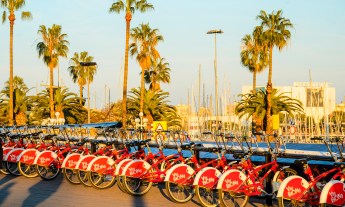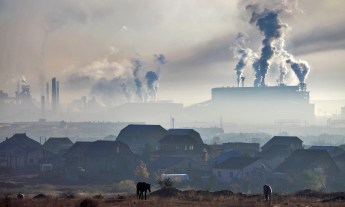
Writers Darrell Bricker and John Ibbitson unpack the Canadian Solution, explaining how the country’s attitude towards refugees and immigrants has set it apart and why other nations should take note if they want to thrive.
The first thing the visitor heard as he approached the cabs outside the airport was a lively discussion in Arabic, which brought him up short. Inuvik is a town of about 3,500 souls, two hundred kilometers north of the Arctic Circle, in Canada’s Northwest Territories. The population is roughly 40 percent Inuit, 40 percent First Nations, and 20 percent everyone else — including about 49 Arabs. There is a mosque in the middle of town, the most northerly mosque on the planet.
It is also typical of the world’s most cosmopolitan country: 20 percent of its population was not born in Canada, a percentage that keeps climbing. Half the population of the Greater Toronto Area, now North America’s fourth largest, is foreign-born. A country of 35.2 million — 5 percent more than there were five years earlier, according to the 2016 census — brings in 300,000 people each year. There’s a push to increase that number to 450,000, bringing Canada’s population to 100 million by 2100.
To equal Canada’s intake on a per capita level, the US would need to accept about 3 million legal immigrants a year — three times its current level.
This is extraordinary — in a century when most developed nations will see populations decline, Canada will continue to grow, robustly. In a world where populations are aging, Canada’s ages more slowly, because the average age of immigrants is seven years younger than the general population. Yes, Canadians worry about the boomers growing old; yes, health care is under stress; yes, politicians argue over whether to raise the retirement age, improve public pensions, or both. But they argue less fiercely than elsewhere.
Canadians have accepted levels of immigration that would flummox people in most countries. To equal Canada’s intake, on a per capita basis, the US would need to accept about 3 million legal immigrants a year — three times its current level. Upon arrival in Canada, do these migrants sink into poverty, living in dingy apartment towers in high-crime neighborhoods? No. Immigrants to Canada are, on average, better educated than native-born Canadians. They flourish in, a largely peaceful, prosperous society. The half-foreign-born City of Toronto, with a population of 2.6 million usually has fewer than 60 murders a year, making it the eighth-safest city on earth.
The message is stark. Any country that wants to stave off the effects of population decline — the sluggish or nonexistent growth; the declining tax base and growing debt; the waning number of young — must adopt the Canadian Solution, an immigration level of 1 percent of population annually, or close to it. Every nation in Europe and Asia with a birth rate at or below replacement rate has the choice to become like Canada, or decline. Yet that might be impossible.
As nations go, Canada is pretty much a failure — but that’s been the secret sauce of its postnational, multicultural success.
Canadians embrace refugees and immigrants because they have learned it is in their interest to welcome them. That discovery is part of its DNA — and the unintended consequence of the fact that, as nations go, Canada is pretty much a failure. But that failure has been the secret sauce of its postnational, multicultural success.
In 1896, Clifford Sifton confronted just about the biggest problem a politician can have. The new Dominion of Canada, barely a quarter century old, was in danger of failing. People didn’t want to live there, and many who were there wanted to leave. The US, recovered from its civil war, surged ahead, as millions streamed from Europe to its shores. But Sifton wasn’t willing to give up. As minister of the interior in the cabinet of Wilfrid Laurier, the first Québécois prime minister, he had to find a way to increase immigration and fill the empty Prairies.
His solution was, for the time, incredibly radical: Aggressively recruit immigrants from Eastern Europe. This idea was anathema to many. The country was already divided between French Quebec and the rest of Canada, a division that threatened the unity and existence of the dominion from its birth in 1867. Diluting the Protestant, Anglo-Saxon culture in English Canada would further weaken it, critics warned. The new arrivals would be Catholic or Orthodox, not speaking English; they’d never integrate.
But Sifton didn’t care. The government flooded Scandinavia, Germany, Ukraine, and everywhere in between with leaflets, touting Canada as the “Last, Best West,” “the New Eldorado,” with “rich virgin lands” that were “protected by the government”. His gamble paid off. Eastern Europeans not only stocked Prairie Canada but became integral to the country. As one person observed, without Sifton we would never have had Wayne Gretzky.
“Well, at least we’re not Americans,” people in Canada concluded. It wasn’t much to hang a nationalist hat on.
With the French and English already estranged, there was no pot for arrivals to melt into, so they kept many traditional ways as they adapted to a new land. Millions more arrived from Europe after the First World War and the Second. As people flooded in, editorialists lamented the lack of a strong national identity. Canada used to be French and British. Now it was French and British and — a lot of other things. “Well, at least we’re not Americans,” people concluded. It wasn’t much to hang a nationalist hat on.
Biases remained. Policies kept Chinese and other Asians from moving there. Then, in the 1960s, a new points system admitted immigrants based on education, job skills, proficiency in English or French, and ties to Canada. Unlike the US and Europe, Canada welcomed the world — but with the stipulation that arrivals had to have the skills and education to find work quickly. First and foremost, immigration was an economic policy, designed to buttress the population. Between the 1990s and now, Canada has brought in the equivalent of three new Torontos, with arrivals from China, India, Philippines, and other nations. Some people warned that these Asian immigrants were too alien and would never fit in. But they fitted in just fine.
If nationalism helps hold a country together, it also excludes. In defining what binds you to others in your nation — your language, religion, genes, shared assumptions (one kiss on the cheek vs. one kiss on each cheek) you are distinguishing your group from other groups. Other settler countries, like the US or New Zealand, have such a strong national ethos that newcomers know they must embrace it or go elsewhere. Canada, not so much. It’s “the greatest hotel on earth,” Canadian writer Yann Martel called it. He said it in praise; others used the phrase to disparage the country.
Keith Banting of Queen’s University has tracked the country’s attitudes toward immigration and found: Canadians aren’t as tolerant as they think they are.
Before we burst into song, let’s admit some uncomfortable truths. Donald Trump’s inauguration in January 2017 spurred fears of deportation among foreigners in the US. Hundreds of people, mostly Somalis, sought asylum in Canada. When summer arrived, many others, mostly Haitians, crossed into Quebec; almost 6,000 in August alone. One poll showed that two-thirds of Canadians did not consider the asylum seekers legitimate refugees. The chaos at the border — at one point, the army was called in to provide temporary accommodation — undermined confidence in Canada’s immigration system.
Keith Banting of Queen’s University in Kingston, Ontario, and his students have tracked the country’s attitudes toward immigration. Canadians, he observes, aren’t as tolerant as they think they are. “The population could roughly be divided three ways,” he argues. “One third of Canadians really don’t support multiculturalism. One third are enthusiastic multiculturalists. And one third are what you could call ‘soft multiculturalists’: They support the current policies, but with reservations. And that support could change.”
In fact, Canadians living outside Quebec aren’t very different from Americans in their attitudes. About 6 in 10 Americans and Canadians oppose allowing religious headgear for police officers and members of the military; about 4 in 10 oppose requiring employers to make a special effort to hire minorities and immigrants; about 2 in 10 oppose allowing women to wear a hijab in public.
And Quebecers are far less tolerant than their counterparts in the rest of Canada. Part of this has to do with the policy of laïcité, the French devotion to secularism that was a reaction to the Catholic Church. Yet many defenders of laïcité also defend the historical ties to Catholicism. So hijabs on the street are an abomination, but the crucifix in the National Assembly is perfectly reasonable.
Canadian politicians must preserve tolerance within the mosaic, a mosaic that’s still a far more successful and resilient structure than nationalism.
Intellectuals and politicians refer to “interculturalism” in Quebec — the effort to integrate other cultures into the majority francophone culture while respecting differences. Quebecers work hard to preserve their identity, with laws restricting the use of English and requirements that children attend French-language schools. Because the ability to speak French advantages immigrants into Quebec, the province has a different mix of newcomers. While the top three source countries for Canada today are the Philippines, India, and China, the top source countries for Quebec are France, Algeria, and China.
Many Quebec immigrants are Muslim, and they tend to be less well educated than immigrants coming into the rest of Canada. So there are tensions. It probably is no coincidence that Quebec takes in a smaller share of immigrants. In 2015, Quebec accounted for 18 percent of immigrants despite having 23 percent of Canada’s population. Quebec grapples with preserving its identity while also bringing in enough immigrants to offset its low fertility rate.
But even in the rest of Canada, a significant minority is uncomfortable with newcomers. Canadian politicians must protect and preserve tolerance and diversity within the mosaic, a mosaic that’s still a far more successful and resilient structure than nationalism of whatever variety. For when it comes to preserving and renewing a society, nationalism can be a curse.
The weaker the culture, the easier the task of promoting multiculturalism. The less the sense of self, the less the sense that another is the Other.
The xenophobic Hungarian prime minister, Viktor Orbán, calls refugees a “poison.” A nation of just under 10 million, Hungary is losing more than 30,000 people a year, and aging rapidly. But Hungary is as Hungarian as Japan is Japanese: 90 percent of the population is ethnically Hungarian, or Magyar. Its language is one of the hardest to learn. Its origins are Uralic rather than Indo-European, and there are 35 different cases and 14 vowels. Even if Hungary did welcome immigrants, people might think twice, for linguistic reasons alone.
The less nationalist the state, the easier the job of absorbing immigrants. The weaker the culture, the easier the task of promoting multiculturalism. The less the sense of self, the less the sense that another is the Other. This doesn’t mean anything goes. Canada remains a nation steeped in the democratic and parliamentary traditions of Great Britain, the free, fraternal and equal aspirations of France, the European principles of religious and social tolerance. Every Canadian who is truly Canadian cherishes these things.
But that’s why people come to Canada, find so many of their own kind there, and live happily and well, although they sigh regretfully when it becomes clear their children have no interest in learning the old language. As a cohesive, clearly defined nation, Canada may be not much to look at. As a tolerant, peaceful, multicultural and growing postnation, it seems to work pretty well.
Excerpted with permission from the new book Empty Planet: The Shock of Global Population Decline by Darrell Bricker and John Ibbitson. Published by Crown Publishing Group, a division of Penguin Random House, LLC. Copyright © 2019 by Darrell Bricker and John Ibbitson.
Watch Darrell Bricker’s TEDxToronto talk here:











